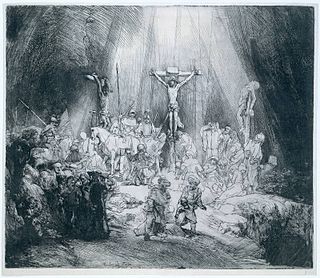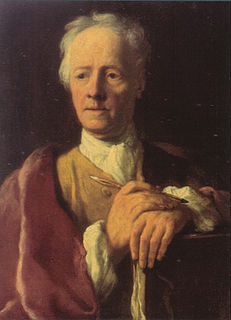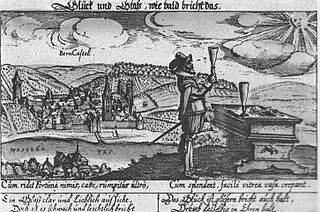
Jacques Callot was a baroque printmaker and draftsman from the Duchy of Lorraine. He is an important person in the development of the old master print. He made more than 1,400 etchings that chronicled the life of his period, featuring soldiers, clowns, drunkards, Gypsies, beggars, as well as court life. He also etched many religious and military images, and many prints featured extensive landscapes in their background.

Aquatint is an intaglio printmaking technique, a variant of etching that only produces areas of tone rather than lines. For this reason it has mostly been used in conjunction with etching, to give outlines. It has also been used historically to print in colour, both by printing with multiple plates in different colours, and by making monochrome prints that were then hand-coloured with watercolour.

Sir Francis Seymour Haden PPRE, was an English surgeon, best known as an original etcher who championed original printmaking. He was one of the founders the Society of Painter-Etchers, now the Royal Society of Painter-Printmakers, and was its first president.

Wenceslaus Hollar was a prolific and accomplished Bohemian graphic artist of the 17th century, who spent much of his life in England. He is known to German speakers as Wenzel Hollar; and to Czech speakers as Václav HollarCzech: [ˈvaːtslav ˈɦolar]. He is particularly noted for his engravings and etchings. He was born in Prague, died in London, and was buried at St Margaret's Church, Westminster.
The Etching Revival is the re-emergence and invigoration of etching as an original form of printmaking during a period of time stretching approximately from 1850 to 1930.

An old master print is a work of art produced by a printing process within the Western tradition. The term remains current in the art trade, and there is no easy alternative in English to distinguish the works of "fine art" produced in printmaking from the vast range of decorative, utilitarian and popular prints that grew rapidly alongside the artistic print from the 15th century onwards. Fifteenth-century prints are sufficiently rare that they are classed as old master prints even if they are of crude or merely workmanlike artistic quality. A date of about 1830 is usually taken as marking the end of the period whose prints are covered by this term.

Jacques Bellange was an artist and printmaker from the Duchy of Lorraine whose etchings and some drawings are his only securely identified works today. They are among the most striking Northern Mannerist old master prints, mostly on Catholic religious subjects, and with a highly individual style. He worked for fourteen years in the capital, Nancy as court painter to two Dukes of Lorraine, before dying at the age of about forty, and almost all his prints were produced in the three or four years before his death. None of his paintings are known to have survived, but the prints have been known to collectors since shortly after his death, though they were out of critical favour for most of this period. In the 20th century they have been much more highly regarded, although Bellange is still not a well-known figure.

Johann Wilhelm Baur, Joan Guiliam Bouwer, or Bauer was a German engraver, etcher and miniature painter. He is famous for a series of illustrations of Ovid's Metamorphoses.

Wendel Dietterlin (c.1550–1599), sometimes Wendel Dietterlin the Elder, to distinguish him from his son, was a German mannerist painter, printmaker and architectural theoretician. Most of his paintings are now lost, and he is best known for his treatise on architectural ornament, Architectura, published in its final edition in Nuremberg in 1598.
Harriet Gouldsmith was an English landscape painter and etcher.
William Baillie (1723–1810) often known as "Captain William Baillie" was an Irish printmaker, known especially for works in the style of, or directly copied from, the etchings of Rembrandt. Usually described as an amateur artist, he was an officer in the British Army until 1761, and later held the post of Commissioner of Stamps. He also acted as an agent for art collectors, most notably Lord Bute.

Jean Barbault (1718–1762) was a French painter, etcher and printmaker, who worked in Rome for most of his life. He is noted for paintings of local people, wearing traditional costumes or Oriental costumes and for his work documenting iconic Roman monuments and antiquities which were published in two volumes.

Johann Friedrich Bause was a German engraver.

Hanns Lautensack was a German etcher and draughtsman.

Franz Joachim Beich was born at Ravensburg, on October 15, 1666. He was the son of Daniel Beich, a painter of little celebrity, from whom he received his instruction in the art.

Abraham Blooteling (1634–1690) was a Dutch designer and engraver.

Simon de Vries or Simon Frisius, was a Dutch engraver.
Eduard Clemens Fechner was a German portrait painter and an etcher.
Davide Antonio Fossati, a painter and etcher, was bom at Morcote, Ticino, Switzerland in 1708, and studied drawing under Vicenzo Maria Mariotti at Venice, and painting under Daniel Gran, with whom in 1723 he went to Vienna. In 1728 he painted the dining-hall in the monastery of St. Martinsberg at Pressburg; but in 1730 he returned to Venice, and in the next year executed the wall-paintings in the villa at Torre, near Este, as also in the nunnery of Santa Margaretta, near Lauis. He afterwards took to etching, but did not succeed at first. His death occurred at Vienna in 1795. His works as a painter are little known, but he has left among his later and happier efforts several etchings of landscapes and historical subjects after various masters.

Sebastian Furck or Fulcarus (c.1589–1666) was a German engraver.















